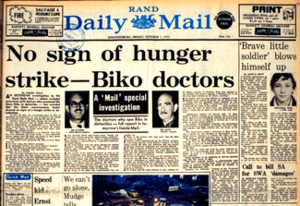The Rand Daily Mail
|
Front page of the Rand Daily Mail | |
| Type | Daily newspaper |
|---|---|
| Format | Broadsheet |
| Owner(s) | Times Media Group |
| Publisher | Clive Kinsley |
| Editor | Ray Hartley |
| Staff writers | 15 |
| Founded | 1902 |
| Ceased publication | 1985 |
| Headquarters | Johannesburg |
| Website |
www |
The Rand Daily Mail newspaper was published from 1902 until it was controversially closed in 1985 after adopting an outspoken anti-apartheid stance in the midst of a massive clampdown on activists by the security forces. The title was based in Johannesburg as a daily newspaper and best known for breaking the news about the apartheid state's Muldergate Scandal in 1979.[1] It also exposed the truth about the death in custody of anti-Apartheid activist Steve Biko, in 1977.
The Rand Daily Mail was resurrected as a website by Times Media Group, who hold rights to the original title, in October 2014.
History
Soon after it was founded in 1902 by Harry Cohen,[2][3] The Rand Daily Mail was bought by mining magnate Abe Bailey.[4]
During the apartheid years, journalists like Benjamin Pogrund reported on political and economic issues affecting black South Africans about which whites were largely ignorant. Pogrund, for example, reported on the Sharpeville massacre of 1960.
In 1963 journalists at the paper wrote about prison conditions, and were the first to report on forced removals. On 3 November 1978 Rand Daily Mail journalists Mervyn Rees and Chris Day reported on the use of public funds since 1973 to set up a disinformation network in South Africa and abroad. The money was used in attempts to buy The Washington Star, and to set up The Citizen as a government-controlled counter to The Rand Daily Mail.[5]
Hounded by the state, the paper's board decided to moderate its content for the sake of attracting more affluent white readers. This strategy led to financial losses and the newspaper was forced to close in 1985, eighty-three years after it was founded. [1]
After its closure, the black newspaper The Sowetan described The Rand Daily Mail as the first white newspaper to regard blacks as human beings. Yet for most of the apartheid period (1948–1990) the paper suffered from poor management, government infiltration, and state censorship.[6] The management often tried to replace more liberal editors with conservative ones.
After the closure of The Rand Daily Mail, some of its journalists (like Anton Harber and Irwin Manoim) pooled their severance pay to start the Weekly Mail (now Mail & Guardian), which carried on the anti-apartheid stance of its predecessor.
Resurrection as a website
Times Media Group held the rights to the Rand Daily Mail, and in 2014 decided to relaunch the title as an online-only brand, utilising opinion content from its stable of newspapers, including The Sunday Times, The Times, Business Day, the Financial Mail, The Sowetan, The Herald, the Daily Dispatch and the Weekend Post.[7][8]
Editors
- 1902–1903: Edgar Wallace[9]:23
- 1903–1904: George Adamson[10]:622
- 1904–1921: Ralph Ward Jackson[10]:622
- 1921–1924: L.E. Neame[10]:624
- 1924–1941: Lewis Rose MacLeod[10]:625
- 1941–1953: George Rayner Ellis[10]:627
- 1953–1957: A.P. Cartwright[10]:628
- 1957–1965: Laurence Gandar (1915–1998)[11]
- 1965–1977: Raymond Louw
- 1977–1981: Allister Sparks
- 2014 – current: Ray Hartley
See also
- List of newspapers in South Africa
- Helen Zille
- Charles Gordon McClure (1885–1933), also known as Dyke White, cartoonist
Notes and references
- 1 2 Renowned South African journalist to teach at School of Journalism and Mass Communication University of North Carolina
- ↑ Nathan, Manfred (1919). The South African commonwealth. Johannesburg, Cape Town: The Specialty press of South Africa Ltd. p. 242.
- ↑ "Latest Foreign News". The Jewish Times and Observer. L (34). 25 August 1905.
- ↑ History of the press in South Africa
- ↑ The Information Scandal sahistory.org
- ↑ Knight 2000.
- ↑ Interview with Ray Hartley The Media Online
- ↑ Radio interview with Ray Hartley 702 Talk Radio
- ↑ Pogrund, Benjamin (2000). War of Words: Memoir of a South African Journalist. Seven Stories Press. p. 381. ISBN 9781888363715.
- 1 2 3 4 5 6 Shorten, John R. (1970). The Johannesburg Saga. Johannesburg: John R. Shorten Pty Ltd. p. 1159.
- ↑ Laurence Owen Vine Gandar Obituary
- Hachten, William A.; Giffard, C. Anthony (1984). The Press and Apartheid: Repression and Propaganda in South Africa. University of Wisconsin Press. ISBN 978-0-608-01935-2.
- Pogrund, Benjamin (2000). War of Words: Memoir of a South African Journalist. Seven Stories Press. ISBN 978-1-888363-71-5.
- Rees, Mervyn; Day, Chris (1980). Muldergate: The Story of the Info Scandal. Macmillan South Africa. ISBN 978-0-86954-089-3.
- Wills, Walter H. (2006). The Anglo-African Who's Who and Biographical Sketchbook, 1907. Jeppestown Press. ISBN 978-0-9553936-3-1.
- Merrill, John Calhoun; Fisher, Harold A. (1980). The world's great dailies: profiles of fifty newspapers. Hastings House. pp. 256 – 263. ISBN 978-0-8038-8095-5.
- Knight, Robin (12 June 2000). "The Daily Courage". TIME. 155 (23). Retrieved 2015-11-10.
Further reading
- Harber, Anton; Renn, Margaret (2010). Troublemakers: The Best of South Africa's Investigative Journalism. Jacana Media. ISBN 978-1-77009-893-0.
